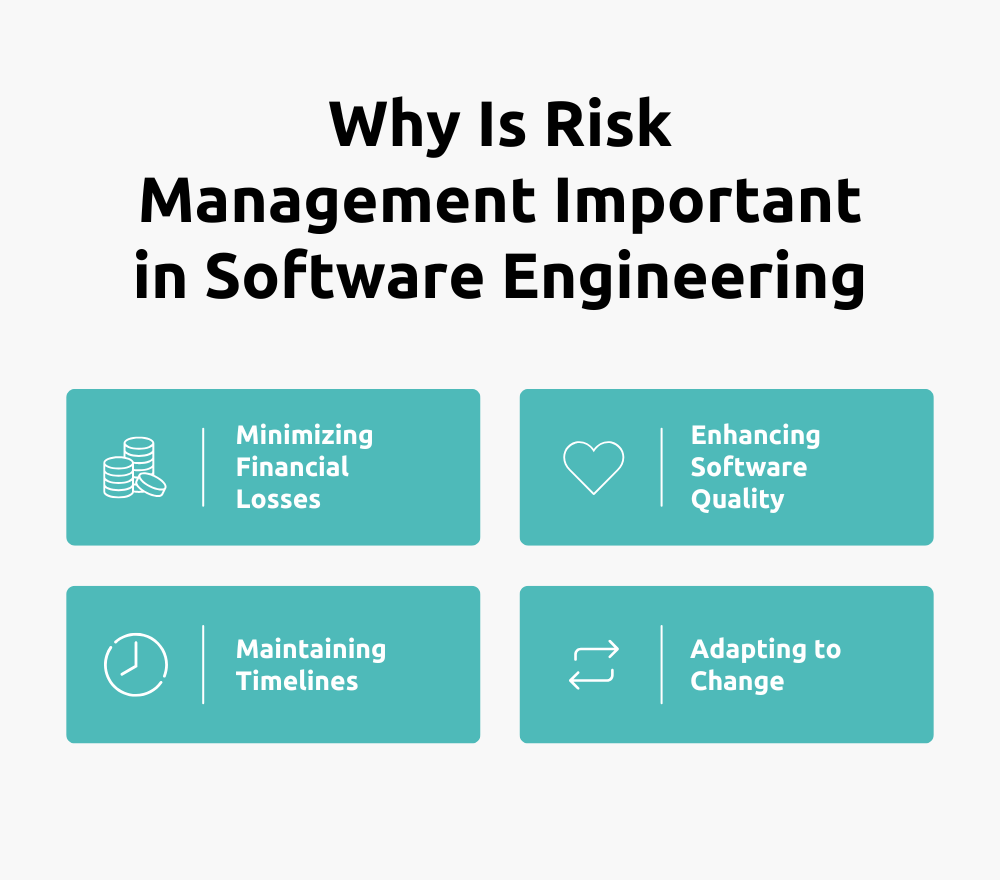Risk Management in Software Engineering

When developing software, risks are inevitable. Deadlines can slip, budgets can overrun, and technical challenges can spiral out of control. But with a structured approach to software risk management, teams can anticipate these challenges and minimize their impact.
According to a McKinsey report, just one in every 200 IT projects meets initial requirements, and only one in every 14 is delivered on time and on budget. Why? The inability to foresee and mitigate risks effectively. This makes risk management in software engineering an essential skill for ensuring smooth project execution and delivering high-quality results.
From identifying potential threats to developing a solid software risk management plan, this guide dives into the practical steps, tools, and insights you need to manage software project risks effectively.
What is Risk Management
Risk management in software engineering refers to the systematic process of identifying, analyzing, and addressing risks that could impact a software project's success. Risks, in this context, are any uncertainties or potential problems that could derail timelines, inflate budgets, or compromise the quality of the final product.
In simpler terms, it's about anticipating challenges before they happen and taking proactive measures to minimize their effects. For example, spotting a potential delay in integrating third-party APIs early allows teams to adjust schedules or find alternatives before it becomes a bottleneck.
The goal of software risk analysis and management is not to eliminate risks entirely – that's impossible. Instead, it's about reducing their likelihood and mitigating their impact so that projects stay on track and deliver value.
Why Is Risk Management Important in Software Engineering

Risk management in software engineering is vital because it directly influences a project's success. Without identifying and addressing risks, software teams may face budget overruns, missed deadlines, and even project failure. A proactive software project risk management strategy ensures better decision-making and a higher likelihood of delivering a successful product.
Minimizing Financial Losses
Delays or unexpected challenges often lead to increased costs. By managing software project risks, teams can avoid expensive rework or resource misallocation.
Maintaining Timelines
Risks like resource shortages or scope creep can push deadlines. Effective risk management in software ensures that potential bottlenecks are identified and addressed early, keeping the project on schedule.
Enhancing Software Quality
Unchecked risks can compromise the quality of the final product, such as bugs, performance issues, or non-compliance with industry standards. A solid software risk management plan safeguards the product’s integrity.
Adapting to Change
In dynamic industries, new technologies and market conditions introduce unexpected challenges. Risk management in software project management helps teams remain flexible and prepared for change.
The Risk Management Process
Risk management in software engineering is an ongoing process with several essential stages. Each step works together to identify, evaluate, mitigate, and continuously monitor risks, ensuring smooth project execution. Below is a deep dive into the critical steps of software risk management.
Risk Identification
This is the first step in software project risk management and involves identifying all potential threats that could disrupt the project. These risks could be related to technology, business, budget, or even human factors.
Common methods include brainstorming with the team, analyzing past projects, and consulting risk databases. It’s important to document these risks in a risk register, listing their possible causes and potential impact.
Risk Analysis & Prioritization
Not all risks are created equal. Once identified, each risk must be evaluated based on its likelihood and potential impact. This is where software risk analysis and management comes into play.
- Quantitative Analysis: Uses measurable data to evaluate risk (e.g., financial impact).
- Qualitative Analysis: Assesses risks based on severity (low, medium, or high).
High-impact, high-probability risks should receive immediate attention, while lower-priority risks can be monitored for future action.
Risk Planning
After analysis, the next step is developing a plan to address each significant risk. A software risk management plan typically includes:
- Risk management methodology
- Roles and responsibilities
- Risk response strategy
- Risk breakdown structure
- Risk assessment matrix
The key is having actionable steps prepared so the team isn't scrambling when risks materialize.
Risk Mitigation
Mitigation involves taking steps to reduce a risk’s impact or likelihood of occurrence. For example, in risk management in testing, performing rigorous code testing early helps identify bugs before they cause significant delays.
Risk Monitoring
Finally, risk management in software doesn't stop after the initial plan. Continuous monitoring is essential to track any new or evolving risks throughout the project lifecycle.
Types of Risks in Software Projects

Software projects face a variety of risks, broadly categorized into project risks, technical risks, and business risks. Each type affects the project in unique ways, and understanding them is crucial for effective software risk management.
Project Risks
Project risks arise from issues related to planning, resource allocation, scheduling, or team coordination, all of which can directly affect timelines and budgets. These risks often stem from poor communication, resource shortages, or unexpected disruptions.
Technical Risks
Technical risks are challenges related to the tools, technologies, or technical processes used in development. These risks can include software bugs, integration failures, or reliance on unproven technologies, potentially leading to delays or compromised software quality.
Business Risks
Business risks involve external factors such as market demand changes, stakeholder disagreements, or economic instability. These risks can misalign the project with business goals, reduce profitability, or make the product obsolete.
Examples of Project Risks in Software Engineering
Let’s dive deeper into how software project risks manifest in real-world scenarios. These examples show the distinct challenges posed by internal risks, external risks, and their combination.
Internal Risks
Internal risks originate within the project team or organization and typically result from mismanagement, poor planning, or lack of resources.
Example:
A software company is building a cloud-based project management tool. Midway through the project, the team realizes that the initial requirements were poorly defined, causing constant rework and feature changes. Developers become frustrated due to unclear objectives, and the project timeline spirals out of control.
Details:
- Poor requirements gathering during the planning phase.
- Increased workload, wasted resources, and low team morale.
- To mitigate, conduct thorough requirement analysis and regular stakeholder reviews to ensure clarity and alignment.
External Risks
External risks arise from factors outside the organization’s control, such as regulatory changes, vendor failures, or geopolitical events.
Example:
An eCommerce company partners with a payment gateway provider for its new website. Weeks before the launch, the provider’s servers experience a prolonged outage due to a cyberattack. This leaves the team scrambling for an alternative solution, delaying the launch and eroding client confidence.
Details:
- Dependence on a single third-party provider.
- Delayed go-live date, client dissatisfaction, and potential revenue loss.
- Always have backup providers and test integrations early in the project lifecycle.
Internal & External Risks Combined
Combined risks occur when internal issues are compounded by external factors, making them more complex to manage.
Example:
A logistics company is developing an IoT-enabled fleet management system. Internally, the team faces challenges with undertrained staff and a lack of robust testing processes. Simultaneously, global chip shortages disrupt the availability of essential hardware components, halting progress.
Details:
- Internal skill gaps combined with external supply chain disruptions.
- Missed deadlines, escalated costs, and reduced client trust.
- Strengthen internal processes (e.g., upskill staff) and diversify hardware suppliers to reduce dependency.
Benefits of Risk Management
Implementing effective software risk management practices offers numerous advantages for software projects:
- Improved Project Outcomes
- Enhanced Decision-Making
- Increased Stakeholder Confidence
- Cost Control
- Better Resource Allocation
- Scalability and Flexibility
Limitations of Risk Management
While software risk management is beneficial, it’s important to recognize its limitations:
- Time-Consuming Process
- Incomplete Risk Identification
- Overhead Costs
- Dependence on Accurate Data
Emerging Risks of 2025
As software engineering evolves, new risks emerge, reshaping how projects are planned and executed. The rapid pace amplifies these risks, making adaptability and foresight essential components of modern software risk management strategies. By recognizing these emerging challenges, software teams can safeguard their projects.
AI Integration
AI integration has become a cornerstone of modern software engineering, automating processes from code generation to predictive analytics. However, over-reliance on AI can be problematic. Flawed models or poorly trained systems may produce unreliable outputs, misclassify critical issues, or fail to adapt to real-world complexities. For example, an AI-driven tool used to automate testing may overlook rare but critical edge cases, resulting in undetected bugs. To mitigate such risks, human oversight is essential, along with periodic audits of AI outputs to ensure they align with project goals and ethical standards.
Cloud Services
Cloud dependencies continue to grow as organizations embrace scalable infrastructure and SaaS solutions. Yet, reliance on third-party providers introduces vulnerabilities. A single outage from a cloud service provider can halt development, disrupt deployments, or compromise customer-facing systems. Beyond outages, sudden changes in pricing models or compliance requirements can strain budgets and derail projects. To reduce these risks, businesses are adopting multi-cloud strategies, diversifying providers, and establishing backup systems to maintain operational continuity when challenges arise.
Cybersecurity
Cybersecurity breaches represent another critical risk, particularly as cyber threats become increasingly sophisticated. Software projects in industries such as healthcare, finance, and eCommerce are prime targets for attacks that exploit vulnerabilities in code or third-party dependencies. A breach can lead to stolen data, damaged reputations, and significant financial losses. Addressing this requires embedding security into every phase of the software development lifecycle, from conducting rigorous vulnerability assessments during testing to adopting secure coding practices and robust encryption mechanisms.
Top 5 Tools for Risk Management in 2025
Modern software projects demand robust tools to identify, analyze, and manage risks effectively. In 2025, several platforms stand out for their ability to streamline software project risk management processes and empower teams to tackle challenges head-on. Here’s an overview of the top five tools shaping the landscape.
Kaseya VSA
Kaseya VSA is a powerful tool designed for IT teams to manage risks related to infrastructure and operations. It provides comprehensive monitoring, automation, and reporting capabilities that help identify potential issues before they escalate. For example, Kaseya’s proactive monitoring of system health ensures that hardware or network failures are detected and resolved quickly, minimizing project downtime.
Jira Align
Jira Align excels in bridging the gap between high-level strategy and day-to-day project execution, making it ideal for risk management in Agile software environments. The platform enables teams to track risks alongside project tasks, ensuring alignment with overall business goals. Its real-time reporting capabilities allow stakeholders to identify bottlenecks or deviations from the plan, enhancing decision-making at all levels.
CURA
CURA is a versatile enterprise risk management tool designed to simplify complex risk portfolios. It offers advanced features like automated risk assessments, workflow management, and customizable dashboards. CURA’s ability to integrate seamlessly with existing systems makes it particularly valuable for large-scale projects where multiple teams must collaborate to address risks effectively.
ServiceNow
ServiceNow is a comprehensive platform that combines IT service management with robust risk and compliance tools. Its integration capabilities allow teams to monitor risks across multiple projects and departments, providing a unified view of the organization’s risk landscape. ServiceNow’s risk scoring and prioritization features help software teams focus on addressing the most critical challenges first.
LogicGate
LogicGate is an agile governance, risk, and compliance platform that allows teams to build workflows tailored to their specific needs. Its visual drag-and-drop interface makes it easy to design processes for identifying, analyzing, and mitigating risks. LogicGate’s strength lies in its ability to adapt to various industries, making it a versatile choice for teams handling diverse software risk management scenarios.
Tips to Mitigate Risks in Software Projects
Effective risk management in software engineering requires a structured approach. Below are key strategies, organized with subheadings for clarity, to help teams minimize software project risks and ensure smoother execution.
Identify and Classify Risks Early
The foundation of software risk management lies in recognizing potential threats. This involves brainstorming sessions with stakeholders, reviewing past projects for recurring issues, and conducting dependency analyses to uncover vulnerabilities. Classification, such as technical, project, or business risks, ensures that risks are addressed with the appropriate strategies.
Prioritize Based on Potential Impact
Not all risks are equal. Assessing risks based on their likelihood and potential impact allows teams to focus their resources where they matter most. For instance, high-impact risks, like critical system failures, should take precedence over less severe challenges, such as minor feature delays.
Address Technical Risks Proactively
Technical risks, such as compatibility issues or scalability challenges, can derail projects if not tackled early. Rigorous testing, technology audits, and the adoption of proven tools and frameworks help minimize technical uncertainties.
Foster Open Communication Among Teams
Transparent communication is vital for effective software project risk management. Teams should share updates on risks regularly, using collaboration platforms like Slack or Microsoft Teams to ensure everyone is aligned on mitigation strategies and project progress.
Adopt Agile Methodologies
Agile practices offer the flexibility needed to adapt to unexpected risks. Regular sprint reviews, iterative development cycles, and stakeholder feedback help teams pivot quickly and address challenges as they arise.
Maintain a Knowledge Repository
Documenting risks, mitigation strategies, and lessons learned ensures that future projects benefit from past experiences. Tools like Confluence or Notion can help organize this information for easy access and collaboration.
Final Words on Risk Management in Software Engineering
Risk management is not just about avoiding failure, but about enabling success. By integrating software risk analysis and management into every phase of your project, you build resilience and confidence, setting the foundation for sustainable growth and innovation. With the right mindset and tools, managing risks becomes a strength that drives project success.
